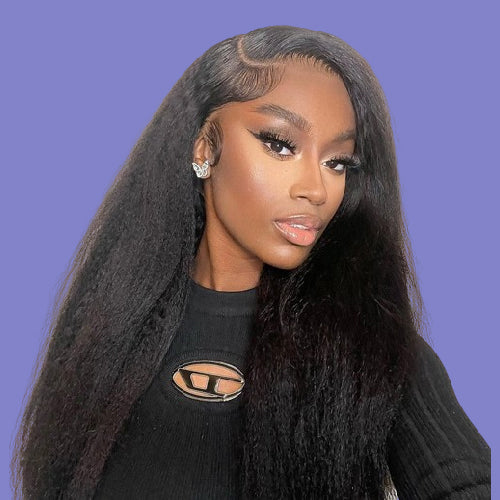How to Stop Human Hair Wig from Matting: A Comprehensive Care Guide
If you love wearing human hair wigs, you know how easy they make it to switch up your style. But there's one big problem that comes with wearing wigs - matting. When the hair gets all tangled and knotted up, it can make your wig look a mess and even cause damage over time. This guide will teach you everything you need to know to keep your wig looking great and tangle-free. You'll learn what causes matting, how to detangle your wig, and the right way to wash, condition, and style it. With just a little extra care, you can make your wig last longer and keep rocking those fabulous looks!
What Causes Wigs to Get Matted and Tangled?
Dealing with a matted, tangled wig is incredibly frustrating. However, understanding what causes those pesky knots can help you avoid them altogether.
Harsh weather conditions like wind, rain, and high humidity can cause wig strands to knot up over time, even if you take excellent care of your wig. The great outdoors can be quite unkind to wigs!
Friction is another major contributor to knots and tangles. Rubbing against rough fabrics like cotton pillowcases or getting snagged on sweaters and jackets can seriously disrupt the smooth flow of your wig's hair.
Using too many heavy products or neglecting to wash your wig regularly can lead to a buildup of gunky residue. This product and oil buildup dries out the strands, causing them to become tangled and matted.
Wigs are constructed differently than your natural hair. The hair fibers are sewn or ventilated into a cap base in a specific direction. When strands start crossing the wrong way, it causes the cuticles to rub together, leading to knots and tangles.
The sooner you catch matting, the easier it will be to detangle. Be on the lookout for any rough, velcro-like sections or strands that start sticking and clumping together. That's your sign to start detangling immediately.

How to Detangle Your Human Hair Wig
Having the right tools for detangling is key to getting those knots out without causing more damage. Here's what you'll need:
Wig Stand or Styling Head
Trying to detangle while holding the wig is pretty much impossible. Using a wig stand or styling head allows you to clearly see all the sections and work through them gently.
Wide-Tooth Comb
Never, ever use a brush on your human hair wig when detangling - this will only make matters worse. A wide-tooth comb glides through gently without snagging or ripping strands.
Detangler Spray
Look for a quality detangler made specifically for wigs and weaves. This helps "lubricate" the strands so you can work through knots more easily.
Step-by-Step Detangling
With your tools ready, follow these steps:
- Place the wig securely on the stand
- Separate the wig into manageable sections
- Mist each section with detangler spray
- Starting from the bottom, use the wide-tooth comb to gently work out knots
Tackling Stubborn Knots
For really stubborn knots, never pull or rip them out. Instead:
- Concentrate more detangler on the knotted section
- Very gently pull apart the knotted strands with your fingers first
- Then slowly comb through the knot in a downward motion
With the right tools, a gentle hand, and a systematic approach, you can work through even the worst matting!
Washing & Conditioning Your Human Hair Wig Right
Keeping your human hair wig fresh and clean is crucial for avoiding matted messes. But you've gotta wash and condition it properly!
Detangle First, Questions Later
Never, and I mean never, skip detangling before you wash. Trying to shampoo a knotted wig is a one-way ticket to Rat's Nest City. Gently work through any knots using the detangling tips from earlier.
Shampoo Smarts
Ditch the regular shampoo you use on your own hair. That stuff is way too harsh for wigs. Instead, grab a shampoo made specifically for wigs and hair extensions. Avoiding harsh sulfates will keep your wig strands silky smooth.
How to Wash Without the Massaging
- Fill up a sink or basin with cool water and your wig-safe shampoo
- Gently swish and dunk the wig in the water to get the shampoo distributed
- Rinse thoroughly but avoid aggressively rubbing and tangling it up again
Leave-In Conditioner is Queen
Just like real hair, conditioning is mandatory if you want a soft, tangle-free wig. But don't put rinse-out conditioner directly on the wig cap - that can loosen up the ventilation traction.
Do this instead:
- Use a high-quality leave-in conditioner made specifically for wigs/extensions
- Apply from the mid-lengths to the ends using smooth, downward strokes
Follow these washing and conditioning tips and you'll have a fresh, moisturized, knot-free wig every single time.

Drying and Styling Your Human Hair Wig Right
Drying and styling your human hair wig properly is just as important as the washing process when it comes to preventing matting. Follow these tips for tangle-free results.
Towel-Drying Technique
- After rinsing out your conditioner, gently blot the wig with a towel to absorb excess moisture
- Avoid roughing up the hair by rubbing vigorously with the towel
- Let any remaining water drain by holding the wig upside down for a few minutes
Air Drying vs. Blow Drying
Air drying is the safest option to prevent frizz, tangles and damage. Simply place your towel-dried wig on a folding wig stand and allow it to air dry completely.
If you need to blow dry:
- Use the coolest setting and keep the dryer several inches away from the hair
- Hold the dryer nozzle downwards and dry in sections to keep hair smooth
- Use a wig-safe heat protectant spray beforehand
Protective Styling is Key
Wearing your wig in protective styles like braids, buns or low ponytails when possible helps minimize friction and tangling from daily wear. When styling:
- Use seamless or silk-covered hair ties to avoid snagging
- Don't make braids or ponytails too tight
- Apply a light leave-in conditioner before styling to reduce frizz
Drying and styling your human hair wig gently and strategically will keep matting at bay for gorgeous, lasting results!
Preventative Measures and Daily Wig Care Routine
Treating your human hair wig right every single day is an absolute must if you want to avoid those dreaded tangles and knots.
Why Daily Care is So Crucial
Look, you gotta think of your wig like your own actual hair - it needs some serious care daily to look and feel its best. Skipping out on a consistent care routine is just asking for a matted rat's nest situation.
The Detangling Product Essentials
Having a good detangler spray or leave-in condish on hand is key for gently working through any new knots or rough spots that pop up day-to-day. Look for formulas packed with nourishing ingredients like argan oil, shea butter or silk proteins.
How to Handle Your Wig Without Destroying It
The way you put that wig on, wear it throughout the day, and take it off at night makes a huge difference when it comes to tangling. Follow these tips:
1. Putting It On:
- Detangle first with your fingers or a wide-tooth comb
- Apply a protective detangling product
- Secure the wig gently, no rough pulling or tugging
2. Wearing It:
- Minimize friction from clothes by wearing silk/satin scarves or wraps
- Avoid heat styling every single day
- Use fabric-covered hair ties for ponytails and updos
3. Taking It Off:
- Remove any clips, pins or hair ties one-by-one gently
- Lift the wig off carefully instead of yanking it
- Detangle and store it on a wig head when not wearing
Stick to this simple daily routine and your wig will stay silky, knot-free and looking amazing. A little preventative care goes a seriously long way!
How to Store Your Wig Properly
Storing your human hair wig the right way is just as important as wearing and washing it correctly. Proper storage prevents major matting when the wig isn't in use.
Use a Wig Stand or Mannequin Head
Never just toss your wig in a drawer or box when you're not wearing it. This will cause the hair to crease, bend unnaturally, and become a tangled disaster.
Instead, invest in an inexpensive wig stand or mannequin head to keep your wig's shape and the hair fibers properly positioned between uses. The stand allows the hair to lay flat and smooth.
Consider Environmental Factors
In addition to using a stand, be mindful of environmental factors that can lead to dry, brittle, matted strands when storing wigs:
- Humidity - Too much moisture in the air can cause frizz and knots. Consider using a dehumidifier or air conditioner in your wig storage area.
- Temperature - Avoid storing wigs in excessively hot or cold areas as extreme temps can damage the delicate hair fibers.
- Light Exposure - Direct sunlight can cause discoloration and dryness over time. Store wigs in a cool, dark place when not in use.
- Dust/Dirt - Always store wigs in a clean, dirt-free space. Dust and grime getting trapped in the hair leads to matting.
By investing just a little time and money into proper wig storage supplies and conditions, you'll keep matting at bay and help your human hair wig look flawless longer.

Keep Your Wig Looking Flawless
Avoiding matting issues and keeping your human hair wig looking gorgeous comes down to consistency. Following the proper washing, conditioning, detangling, styling, and storage methods is crucial, but you've also got to treat your wig with a daily care routine - just like your own natural hair. With a little preventative care using the right wig-safe products and gentle handling techniques, you can rock silky, knot-free strands for much longer. So commit to doing the work - detangling regularly, minimizing friction and heat styling, and storing your wig properly on a stand in the right environment. Stay dedicated to this comprehensive care guide, and say goodbye to matted woes while hello to fierce, flawless looks every time you slay that wig!







Leave a comment